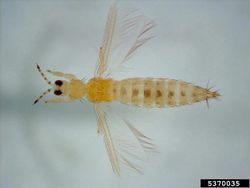Frankliniella occidentalis
| Literature database |
|---|
| 1101 articles sorted by: |
| • year (descending) |
| • research topics |
| • countries/regions |
| • host plants |
| • list of natural enemies |

Author: Jack T. Reed (Mississippi State University)
Source: IPM Images
Frankliniella occidentalis (Pergande 1895) (western flower thrips)
The thrips is highly polyphagous (also a facultative predator of spider mites) and was originally confined to the New World. Since the 1980's it is an important pest of greenhouse vegetables, other crops and ornamentals in many regions. It damages the surface of leaves, fruits and flowers, feeding on the outer cells and causing scarring. Significant economic damage frequently occurs on crops like vegetable (e.g. beans, tomatoes, cucumber or green pepper), fruits like strawberries and peach, as well as on ornamentals. The species is also an important vector of plant viruses like Tomato spotted wilt virus, Chrysanthemum stem necrosis virus, or Impatiens necrotic spot virus.
On the other hand the thrips also feeds on eggs of spider mites and it can delay the development of mite outbreaks. Mite eggs in the diet seem to increase the reproduction of the thrips.
| Vernacular names | |
|---|---|
| • Deutsch: | Kalifornischer Blütenthrips |
| • English: | western flower thrips alfalfa thrips |
| • Español: | trips occidental de flores trips de California |
| • Français: | trips des petits fruits trips occidental de fleurs |
The adults are 1-1½ mm long and the coloration can be variably brownish, pale yellow or reddish. Diagnostic features for this species are listed on the right according to Riley et al. (2011) and illustrated below.
| Diagnostic features: | |
|---|---|
| • | colour yellow to brown |
| • | eight-antennal segments |
| • | pronotal anteromarginal setae equal in length to anteroangular setae |
| • | postocular seta IV pronounced |
| • | tergite VIII comb present and complete with long and irregular setae |
For larvae see Skarlinsky & Funderburk (2016).
Synonyms
Euthrips occidentalis
Frankliniella californica
Frankliniella moultoni
For a review on the management of F. occidentalis see Mouden et al. (2017).
- Other images of Frankliniella occidentalis (PaDIL and IPM Images - click to enlarge)







